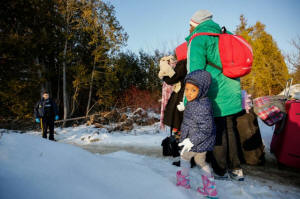|
Collateral damage: How Trump threw
Canada's refugee system into turmoil
 Send a link to a friend
Send a link to a friend
 [March 19, 2018]
By Anna Mehler Paperny [March 19, 2018]
By Anna Mehler Paperny
TORONTO (Reuters) - Buffered by three
oceans and the United States to the south, Canada has for decades had
the luxury of being able to pick and choose its newcomers. So few asylum
seekers crossed the U.S. border illegally over the years that Canada
didn’t consistently track the numbers.
That has changed dramatically over the past 14 months. U.S. President
Donald Trump's crackdown on illegal immigration and his move to strip
Haitians, Salvadorans and others of their temporary legal status have
had a broad effect on Canada’s refugee system, Reuters interviews with
social service providers, government officials and a review of Canadian
immigration data show.
More than 20,000 people, including thousands of Haitians and Nigerians
and hundreds of Turks, Syrians and Eritreans, have crossed the border
into Canada illegally over the past year in search of asylum, many
fleeing in fear that Trump would deport them to their home countries.
This unexpected northward migration has overwhelmed Canada's system for
processing asylum claims, leading to the worst delays in years. Aid
agencies are also struggling to house asylum-seekers because of a
shortage of accommodation in the four cities most affected by the
migration wave - Toronto, Montreal, Winnipeg and Vancouver.

(For graphics on the impact see http://tmsnrt.rs/2HCp4aD)
While some of this has been reported, this story offers the most
complete picture to date of the unintended effect of Trump's immigration
policies on the United States' northern neighbor.
The Canadian government was forced to set aside C$173 million in its
latest budget to pay for extra patrols at border crossings to cope with
the influx, as well as security screening and processing of refugee
applications.
Prime Minister Justin Trudeau's government has discussed the situation
with the Trump administration, but it has been careful not to publicly
blame the U.S. president's policies for triggering the migration wave.
Nevertheless, it is already making preparations for more people to cross
the border once the weather warms.
“We will be ready,” Immigration and Refugee Minister Ahmed Hussen said
in an interview.
Aid agencies who are at the forefront of dealing with the influx say
they are struggling and need more funding, a comprehensive long-term
plan and better coordination with Ottawa.
“It’s going to get worse. The numbers keep climbing,” said Ilona Beiks,
vice president of the Inland Refugee Society of British Columbia, which
had to turn away refugees last year for the first time in its 35-year
history because it did not have enough money to cope with the growing
number of asylum seekers.
The influx shows no signs of abating. More than 1,500 asylum seekers
walked across the border in January. Those working with refugee
claimants say this is no blip: It’s the new normal.
Since January 2017 Reuters has sought to obtain the numbers of asylum
seekers who walked across the U.S. border into Canada in the years prior
to Trump's election. The Canadian government has said no national
historical data is available.
WORSENING DELAYS
Trump's tougher immigration policies have had a major impact on Canada’s
Immigration and Refugee Board, which determines refugee claims. It has
become so overwhelmed with cases it is ignoring legislated time limits
for dealing with them.

All refugee claims are supposed to be processed within 60 days.
Increasingly, the board has failed to meet those targets. In December
2017, 86 percent of hearings did not happen within prescribed time
frames, according to previously unpublished data reviewed by Reuters.
That was up from 66 percent in December 2016, a month after Trump was
elected president, and 26 percent in December 2015.
On Feb. 20 the board said it will effectively prioritize those
applicants who have been waiting months or years. This will mean a
longer wait for more recent arrivals than the current 20-month average
estimated time for processing claims.
The government is “committed to an efficient and fair asylum system,"
said a spokesman for Immigration, Refugees and Citizenship Canada, the
government department responsible for the Immigration and Refugee Board.
Canada’s refugee tribunals have historically been leery of claims made
by people who come through its wealthy southern neighbor. But of the
more than 2,500 claims finalized last year, 53 percent were granted
refugee status.
Rulings reviewed by Reuters indicate the tribunals are giving credence
to claimants who say they feared deportation or racist attacks following
Trump's election on a platform advocating more restrictions on
immigration.
ACCOMMODATION SQUEEZE
Asylum seekers are walking across the border into some of the tightest
housing markets on the continent.
Last summer, thousands slept in Montreal’s Olympic stadium.
In Toronto, 31 percent of the people sleeping in city-run shelters in
January were refugee claimants – up from nearly 19 percent a year ago,
according to city data.
[to top of second column]
|

A girl waits with her family before crossing the US-Canada border
into Canada in Champlain, New York, U.S., February 14, 2018.
REUTERS/Chris Wattie

In November, Toronto approved the booking of more hotel rooms for
refugee claimants through the end of 2018, at a cost of about C$20
million, according to city documents.
The city is working on a more comprehensive refugee plan but it
needs more help from the federal government, said councillor Kristyn
Wong-Tam. The status quo, renting thousands of hotel beds, “is
absolutely unsustainable,” she said.
“We are not saying ‘No’ to refugees. We are saying, ‘Absolutely:
Come and live in Toronto. Build your life in Toronto.’ But we cannot
do this without the support of other orders of government,” she
said.
Toronto’s mayor “has raised this issue repeatedly with the federal
government,” the mayor's spokesman, Don Peat, wrote in an email.
The federal government says it won’t give cities more money for
asylum seekers, who are barred from accessing a C$762 million
federal fund that is for permanent residents or people who have
already been granted refugee status.
A spokesman for Hussen, the immigration minister, said asylum
seekers can access provincial programs. Some agencies Reuters spoke
with, however, said that isn’t enough and that a national effort is
needed.
Toronto is not alone in asking for help. Vancouver has asked the
British Columbia provincial government for more money for refugee
aid agencies, said city spokesman Jag Sandhu, and the province has
promised C$6 million a year over three years. Winnipeg is
coordinating with the Manitoba government to find accommodation for
refugee claimants, the city said.
'WE'RE STRUGGLING'
Canada has no formal system for integrating refugee claimants and
depends heavily on aid agencies that operate independently but are
funded through a combination of government grants and private
donations.

Dozens of agencies in Toronto, Winnipeg, Vancouver and Montreal are
taking the lead in housing and feeding new arrivals and helping them
find schools and employment.
Of 17 organizations Reuters spoke with, 11 said interviews with
border crossers confirmed that many were fleeing because of Trump's
immigration policies.
“We know the numbers have increased because of what’s going on in
the U.S.,” said Toronto-based doctor Meb Rashid, who runs the
provincially funded Crossroads Clinic.
The number of patients at the clinic grew 40 percent in a year and
people now wait several weeks for an appointment, Rashid said.
“We’re struggling, I have to be honest with you."
Two aid groups said they have had to turn people away, one has had
to intensify its fundraising, two have had to extend their operating
hours to meet demand, while six who help to house new arrivals are
struggling to find accommodation for them.
The Manitoba Interfaith Immigration Council in Winnipeg has seen its
refugee claimant caseload increase fivefold in the past year, said
executive director Rita Chahal.
“The impact has been huge,” she said, adding that the organization
had to launch its first fundraising drive in years to meet the
additional costs.
The Canadian government has dispatched lawmakers to diaspora
communities in the United States to persuade people not to come. But
it has said little about what conversations it has had with
Washington on stemming the migration.
The spokesman for Hussen, the immigration minister, said Canada has
a “long-standing, solid working relationship” with the United
States.

Meanwhile, the contingency plans being developed to deal with the
expected surge in border crossers include redeploying police and
border agents to overwhelmed areas and setting up accommodation such
as tents and trailers at ports of entry, said a spokesman for the
Canada Border Services Agency.
“There is an expectation the numbers will go up ... as the weather
gets better,” said a source familiar with the Canadian government's
thinking. “And who knows what the next order coming from down south
will be?"
(Reporting by Anna Mehler Paperny; Editing by Ross Colvin)
[© 2018 Thomson Reuters. All rights
reserved.]
Copyright 2018 Reuters. All rights reserved. This material may not be published,
broadcast, rewritten or redistributed.
Thompson Reuters is solely responsible for this content. |